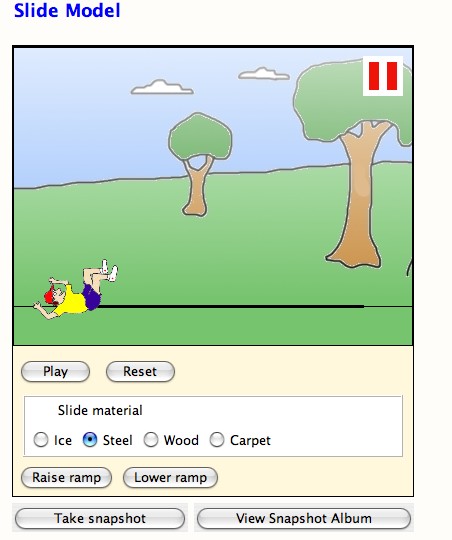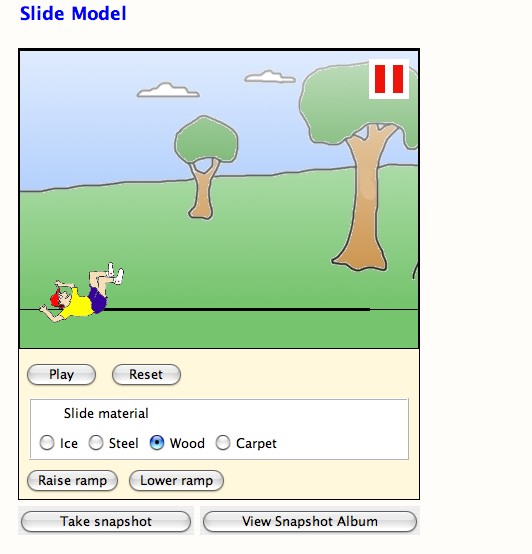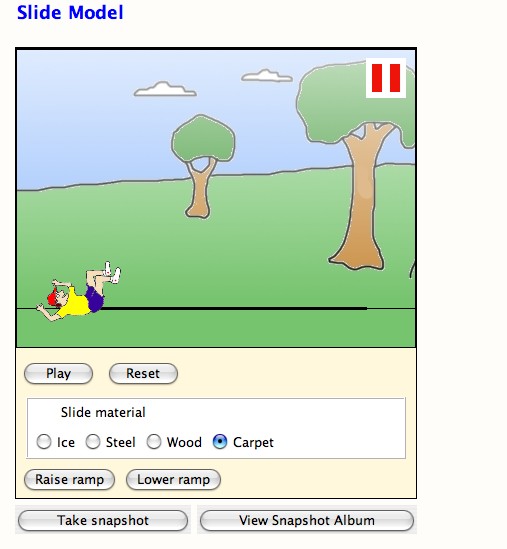Playground surfaces
Discovery question
What happens when you change the surface of a playground slide?
Cannot resolve external resource into attachment.
In this activity, you will compare different surface materials for a slide.
Engage
Affective Network Coach - Engage & motivate - Why learn this? |
Strategic Network Coach - Planning & performing tasks - How do I do this? |
Recognition Network Coach- Gathering facts & describing - What is happening? |
Cannot resolve external resource into attachment. |
Which surface would be the most like Sticky World?
|
Which surface would be most like Slippery World?
|
Write in the boxes below the surface materials in order from the most sticky to the most slippery.
In this model you can change how steep the slide is. You can also change the surface of the slide. You have four choices of material:
Steel: [icon] 
Wood: [icon] 
Ice: [icon] 
Carpet: [icon] 
More friction (sticky)
[four separate text boxes]
Less friction (slippery)
Explore
[Insert slide model] 
| Cannot resolve external resource into attachment. Technical Hint: How to work the Model: Small [TV icon: animated GIF |
In the model above, test the steel surface material by clicking on the circle for steel.
1. Click the Play button and lift the slide by clicking the Raise ramp button. Wait a couple seconds after clicking the button to see if the boy starts to slide. If he does not move, click Raise ramp again. Count how many times you clicked the Raise ramp button before the boy started to slide.
2. Use the Reset button to test the steel surface material again.
3. Record your results of the height needed to start the boy to slide in the table below.
Enter:
Number of clicks on the Raise ramp button to start the boy sliding in the table.
Steel
Affective Network Coach - Engage & motivate - Why learn this? |
Strategic Network Coach - Planning & performing tasks - How do I do this? |
Recognition Network Coach- Gathering facts & describing - What is happening? |
Explore page 2

Now test the wood surface material by clicking on the circle for wood.
1. Click the Play button and lift the slide by clicking the Raise ramp button. Wait a couple seconds after clicking the button to see if the boy starts to slide. If he does not move, click Raise ramp again. Count how many times you clicked the Raise ramp button before the boy started to slide.
2. Use the Reset button to test the wood surface material again.
3. Record your results of the height needed to start the boy to slide in the table below.
Material
Number of clicks on the Raise ramp button to start the boy
sliding
Steel
Wood
Explore page 3

In the model above, test the ice surface material by clicking on the circle for ice.
1. Click the Play button and lift the slide by clicking the Raise ramp button. Wait a couple seconds after clicking the button to see if the boy starts to slide. If he does not move, click Raise ramp again. Count how many times you clicked the Raise ramp button before the boy started to slide.
2. Use the Reset button to test the ice surface material again.
3. Record your results of the height needed to start the boy to slide in the table below.
Material
Number of clicks on the Raise ramp button to start the boy
sliding
Steel
Wood
Ice
Explore page 4

In the model above, test the carpet surface material by clicking on the circle for carpet.
1. Click the Play button and lift the slide by clicking the Raise ramp button. Wait a couple seconds after clicking the button to see if the boy starts to slide. If he does not move, click Raise ramp again. Count how many times you clicked the Raise ramp button before the boy started to slide.
2. Use the Reset button to test the carpet surface material again.
3. Record your results of the height needed to start the boy to slide in the table below.
Material
Number of clicks on the Raise ramp button to start the boy sliding
Steel
Wood
Ice
Carpet
Explain
1) Did the kid slide on all of the surface materials?
|
2) As the results of your test, again place the surface material icons in order from the most slippery to the most sticky.
Steel: [icon] 
Wood: [icon]
Ice: [icon] 
Carpet: [icon] 
Most slippery
[four separate text boxes]
Most sticky
Elaborate
Is there a material on a slide that you could sit on that would not allow you to move down the slide? (Yes/No)
Affective Network Coach - Engage & motivate - Why learn this? |
Strategic Network Coach - Planning & performing tasks - How do I do this? |
Recognition Network Coach- Gathering facts & describing - What is happening? |
Evaluate
How is the model like the real world?
a) The stickier the surface the harder it is to slide.
b) The more slippery the surface the harder it is to slide.
c) The stickier the surface the easier it is to slide.
d) The height of a slide can be changed easily.
Explain your answer to the above question.
|